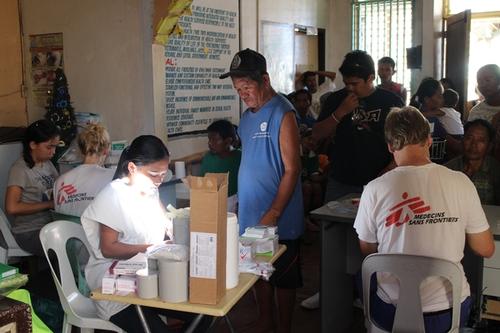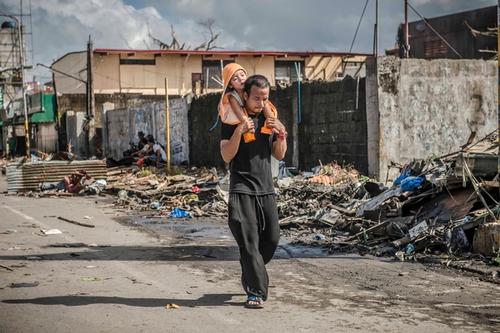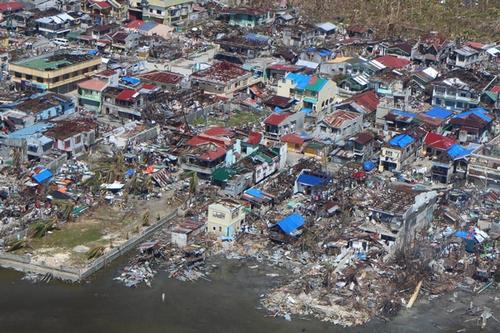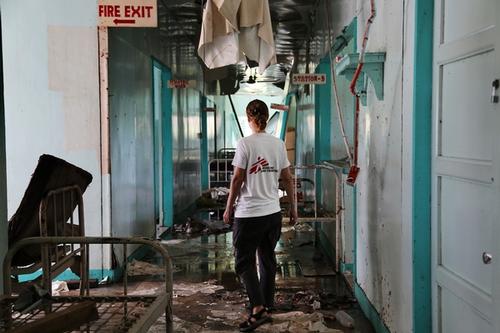MSF emergency coordinator Caroline Seguin describes the challenges in delivering aid.
Almost 10 days after typhoon Haiyan struck the Philippines, aid is reaching airports, ports and cities, but people in many rural areas are still struggling without assistance, says Médecins Sans Frontières (MSF) emergency coordinator Caroline Seguin. She describes the huge logistical challenges of getting emergency aid to where it’s needed most.
"In the days since the typhoon hit, we’ve managed to bring more than 150 staff and hundreds of tonnes of supplies into the country. Now MSF is treating hundreds of patients a day, but the logistical nightmare of getting essential supplies out to the affected areas continues.
Lashing rain and blocked roads
First it was the terrible weather, with rain and strong winds hampering the relief efforts, and roads blocked with debris. Then there was also the problem of bringing staff and supplies in by plane, as the Philippine military was given priority so they could secure airports and cities such as Tacloban, but also evacuate people and wounded from the disaster areas. When commercial and private flights resumed, the airports immediately became congested with the influx of aid. We looked at transport options by water, but this was very slow, sometimes taking 30 or 40 hours to reach the affected areas.
Airports jammed
It’s primarily to do with the logistical capacity of the small airports in the region affected by the typhoon, and the fact that they simply can’t handle much traffic. They also lack the infrastructure needed for unloading and warehousing the massive amount of cargo that needs to come in. Of course, it’s not just people and cargo trying to get in; there are also a lot of planes trying to evacuate people from the disaster zone.
Evacuating the wounded
In the areas where we are working, most severely wounded people have been evacuated over the past week, as well as many who weren’t injured. Those who get evacuated are often the people who can afford it, while those who stay are the most vulnerable.
Fuel shortage
Fuel is also a major problem. In Guiuan, in the east of Samar island, there is no fuel. We have been using a shared car borrowed from the local council, and we don’t have enough fuel to drive outside the town. So we are sending a car to Guiuan by plane, while a lifeboat loaded with small containers of fuel is on its way there from Cebu. Once we have fuel, we’ll be able to reach the isolated areas along the eastern and southern coasts of Samar which so far haven’t received assistance.
Local volunteers do lion’s share
The Filipino people – locals and people from other parts of the country – are doing the lion’s share of the relief work. The work by volunteers has been enormous. It’s amazing – I’ve seen distributions of food, teams of volunteers, drivers, people lending their buildings, cars, boats – and all for free. People are extremely supportive of our work and of international assistance in general. In Palo, the governor has lent us his car, including fuel, and the department of health has provided the team with accommodation. A diving company has even lent us a boat to transport our supplies from Cebu to Guiuan.
Sheltering in schools and stadiums
The situation in Tacloban is catastrophic. Several hospitals have to do surgery and caesarean sections without sterilisation. There are shortages of drugs, including antibiotics. There are more and more infected wounds. At a health post in Palo, to the south of Tacloban, 70 per cent of consultations are for infected wounds. And due to the unhygienic conditions and the lack of access to clean water, diarrhoea is on the rise. People are still gathered in schools and in stadiums. The needs are overwhelming.

No aid at all in some rural areas
Right now, the aid effort is quite concentrated on Tacloban, and certainly the needs are huge there. But in places just a few kilometres away, such as Palo, Tanauan and Tolosa, there is almost no assistance. In Tolosa, there’s one medical post for the 55,000 people living in the area. In Talawan it is even worse – there is nothing. The mayor is looking for a place to set up a camp for 5,800 displaced families who are without shelter, water or food for survival. The further you go towards rural areas, the less aid there is, and in some places there is no aid at all. The people have no other choice than to sleep out in the open while heavy rains continue to fall every day.
Immediately following the typhoon there was an influx of organisations of varying sizes and with differing capacity to deliver assistance. Some have very few supplies and will only stay for two to three weeks.
Food and water shortages
In many areas, people keep asking about food, and they don’t have enough clean water. To prevent health problems in an emergency situation like this, people need 20 litres of clean water per day for drinking, washing and cooking. A small plastic bottle of water per day is not enough.
It is still raining a lot, and shelter is a major issue. We plan to distribute tents, but with fuel shortages making transport impossible, it will only happen this week. We will also distribute basic relief items, such as hygiene kits and cooking equipment.
Significant health needs
With so many health facilities damaged or destroyed, the healthcare needs are significant, especially since the living conditions exacerbate the risk of respiratory tract infections, pneumonia and waterborne diseases. In most areas where MSF is working – Panay, Guiuan, Ormoc, Tacloban and Burauen – the health services have been severely disrupted and we’re focusing on restoring quality primary healthcare and hospital services. In Guiuan, a tent hospital has been put in place in the premises of the damaged reference hospital, while in Tacloban, an inflatable hospital will be set up this week and will provide all services including emergency room, inpatient department, and operating theatre. At the moment, women with complicated deliveries have nowhere to deliver safely or undergo a caesarean section, so MSF teams will urgently set up maternity, obstetrics and gynaecology units. In such an apocalyptic situation, the need for mental health services is overwhelming. All of our teams include mental health officers or psychologists. It’s an extremely important aspect of our response, and quite straightforward to implement compared with other more logistically challenging services."






